The Ottoman concept of „Kizil Elma”, the „Golden / Red Apple”

We know that the Ottomans regarded the important Christian towns which were the targets of their imperial desires as „Golden Apples”.
The Byzantine concept
According to Simge Topaloglu, the connection to apples comes from the Column of Justinian I, which was erected in 543 A.D. (It must have been similar to Çemberlitaş – which is the Column of Constantine – and is – thankfully! – still standing.) At the top of the column, there was a statue of Justinian I on horseback. And Justinian I was depicted as holding a Globus Cruciger in his left hand, while the palm of his right hand facing the East as if to stop the “barbarians” threatening to come from the East:
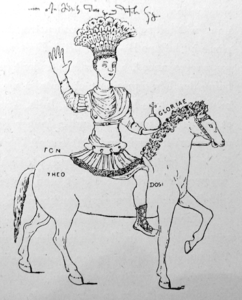
Also:
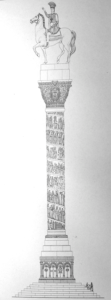
Globus Cruciger means “cross-bearing orb” in Latin, and you may have seen it many times, in different contexts. Here is the Hungarian one:

The ancient Turk concept
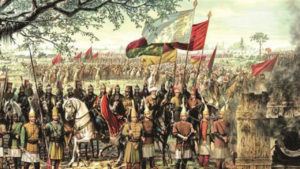
“Red Apple” is an expression for Turks in Turkish mythology, and especially for Oghuz Turks, symbolizing goals, ideas, or dreams that have moved away as they are thought but whose attraction has increased as far as they get away.
While it is not known exactly when, where, and how the Red Apple image appeared, the common understanding among the Turks is that it was a symbol of jihad, which was carried out especially towards the Western countries during the Ottoman period. The Red Apple idea was especially popular among Janissaries and was used to keep their determination to fight high; Ziya Gökalp combined this image with the Turan Ülküs, giving it a new meaning.
“Kızıl” is a color that is generally considered valuable in Turkish culture; “Apple” has a mystical side; it is a fruit that is seen as a source of abundance, fertility, and healing. However, it is believed that the symbolization of the Red Apple is not based on apples, but on the red ball that describes the Sun and the Moon for the Old Turks. This ball adorned the top of the flag and brig under the name ‘muncuk’ and sometimes expressed the sign of victory, sometimes the symbol of domination, and sometimes the target location for conquest.
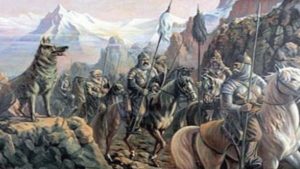
The Red Apple image was born among the Central Asian Turks; Ergenekon Epic is considered to represent the idea of going out from Ergenekon and retrieving the lost old homeland. On the other hand, the Oguz, who came from Turkistan to the east of the Caspian Sea, had the desire to capture the golden ball, the Red Apple, which was found as an expression of his domination over the silk tent of the Caspian khagan.
The Red Apple legend became widespread among the Janissaries after the conquest of Constantinapolis. Various sources, starting from the reign of Fatih Sultan Mehmet III say that the important cities that the Ottomans wanted to conquer in Europe were called “Red Apple”. In Ottoman works on the acquisition of Nándorfehérvár aka Belgrade in 1521, the Battle of Mohacs in 1526, and the 1st Siege of Vienna in 1529, it was mentioned that Sultan Suleiman “took the Red Apple”. In one place of Gelibolulu Mustafa Külî’s Kühnü’l-Ahbar, Red Apple is associated with Portugal; elsewhere, it is associated with “a large church in the most remote corner of the country of the Franks”. Literary historian Orhan Şaik Gökyay stated that some of the churches in question is Saint Pierre Church in Rome.

A second variation of the legend:
According to a Croatian nobleman who was captured by the Turks at Mohács in 1526, Bartholomaeus Georgievicz aka Georgievics Bertalan, there was another version of the legend. Georgievicz also recounted a prophecy that was allegedly widespread in the lands of the Turkish. This prophecy, dubbed “the prophecy of the infidels in the Turkish language,” described when and how the Turks would be defeated by the infidels, i.e., Christians. He quotes:
“Our Emperor [the sultan] will come, he will take away the kingdom of an unbelieving prince, and will also seize the Red Apple [Kuzul Almi] and hold it under his sway. If unto the seventh year, the sword of the Christians shall not have arisen, unto the twelfth year he shall rule them. He will build houses, plant vineyards, put hedges around the gardens, and beget children [which may mean that the Grand Turk will construct mosques and public buildings, establish new colonies, conquer new cities and fortify them, and foster the spread of Islam everywhere in the Ottoman Empire]. After the twelfth year, from the time the Red Apple shall have been made to submit to his power, the sword of the Christians will appear, which will turn the Turk around and put him to flight.”

Interestingly enough, in this prophecy the Red (or Golden) Apple appears as a kind of poisoned chalice – a place that the Turks conquer, but that eventually halts and reverses their progress in Europe due to a Christian uprising.
The Gold Apple in Hungary

Nándorfehérvár aka Belgrade, the gateway to the Hungarian Kingdom, was just such a fruit, and Buda Castle was the next one to pick. The rest of the apples, like Vienna or Rome, were still hanging on their branches. The concept was simple: attack the enemy in waves, burn their land, and spread terror, kill the peasants or enslave them, isolate the forts, and destroy the villages around them. Sooner or later, the apple will fall in your lap. The previous inhabitants can always be substituted by new settlers.
However good the Ottomans were at apple-picking, the stubborn Hungarians had been crossing their apple-picking since the end of the 14th century until the last siege of Vienna in 1683. It is not surprising that the Hungarians knew a lot about the concept of „Kizil Elma”, they even had a legend about the Golden Apple from the time of King Matthias Corvinus (1443-1490).
It is almost identical to another Turkish legend, let’s compare them quickly.
The idea of the „Kizil Elma” was also recorded by Konstantin Mihailovic, a Serb soldier who lived in the Ottoman Empire between 1455 and 1463. In his book, „Memoirs of a Janissary” he tells us a story about Sultan Mohamed II (1432-1481) who had heard the news that the Pope and the Christian powers wanted to attack him.
„The Sultan was worried that his Christian subjects would rebel against him on the newly conquered European lands so he summoned his viziers and commanders. The officers’ advice was to prevent the Christian attack with a quick campaign as it was always better to wage a war on the enemy`s land.
Yet, the Sultan had a different idea and gave an order to his servants to bring in a huge carpet and lay it down in his reception hall. He had an apple placed in the middle of it. Then, he asked the following riddle from his viziers:
„Could any of you pick up that apple without stepping on the carpet?”
His men thought hard and discussed it at length with each other, but none of them could solve the puzzle. Finally, it was the Sultan himself who solved it. He stepped to the carpet and began to roll it up with his two hands. Doing so, he reached for the apple. After this, he rolled the carpet back down as it had been before. Then, he addressed his viziers like this:
„It is more correct to crush the Ghiaours gradually rather than invading their lands all at once. It is advisable because our present situation is so unsteady that the smallest failure we might suffer there, could result in losing all the lands we had conquered so far. The Ghiaours would rebel and attack us at once.” – and all the lords and viziers praised the talk and the example of the Sultan.”

The Hungarian version of the legend was preserved by Ferenc Móra who collected it in a Hungarian village in the 19th century. It is almost identical to the Turkish one. The name of the tale is „Aranyalma” (Golden Apple). It says that King Matthias was attacked by three enemies at the same time, the Germans, the Turks, and the Polish. He decided to send the best of his generals against the Germans and the Turks.
As for the Polish, he thought that one of his pages would be good enough to lead his army. He summoned his seven pages and gave them the very same riddle that the Sultan had given to his viziers. Whomever of them could pick the apple without stepping on the carpet would be allowed to go against the Polish. Finally, a brainy young man rolled the rug up and got the apple. He was sent to the north and defeated the attacking Polish army. King Matthias rewarded him with a golden velvet robe and ennobled him. The page became the ancestor of the Almásy family, „alma” standing for „apple” or in Turkish, „elma”.
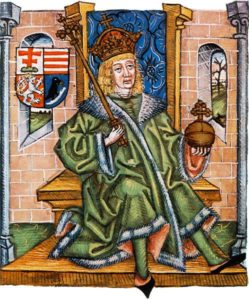
To this day, in the family’s coat of arms is an armored arm, holding a golden apple…
It was the Polish Marcin Bielski Sprawa who mentioned Hungary as the Golden Apple in 1569. He wrote: „przedmurze Czy tarcza Chrześcijaństwa” – The Polish sentence stands for: “a Golden Apple chewed by the worm” in English.
It is in his work called “Rycerska” that was a political satire and he meant it for Hungary’s peril. He also added the well-known citation of Virgil:
“if the neighbor’s house is on fire, it can easily burn the next house, too”
He says that the Hungarian Kingdom before the Defeat of Mohács “used to be the shield of entire Christian Europe but because of carelessness and the inner fights between the Christian lords, the Golden Apple has become a victim of worms, to the harm and damage of the whole Christendom.”

(Source: Szerecz Miklós and Fodor Pál, Hungarian historians, Simge Topaloğlu, and https://www.sozcu.com.tr/2018/gundem/kizil-elma-ulkusu-ne-anlama-geliyor-kizil-elma-nedir-2805050/)
Dear Readers, I can only make this content available through small donations or by selling my books or T-shirts.
If you like my writings, please feel free to support me with a coffee here:
You can check out my books on Amazon or Draft2Digital, they are available in hardcover, paperback, or ebook:
https://www.amazon.com/dp/198020490X
or at https://books2read.com/b/boYd81


My work can also be followed and supported on Patreon: Become a Patron!http://Become a Patron!


